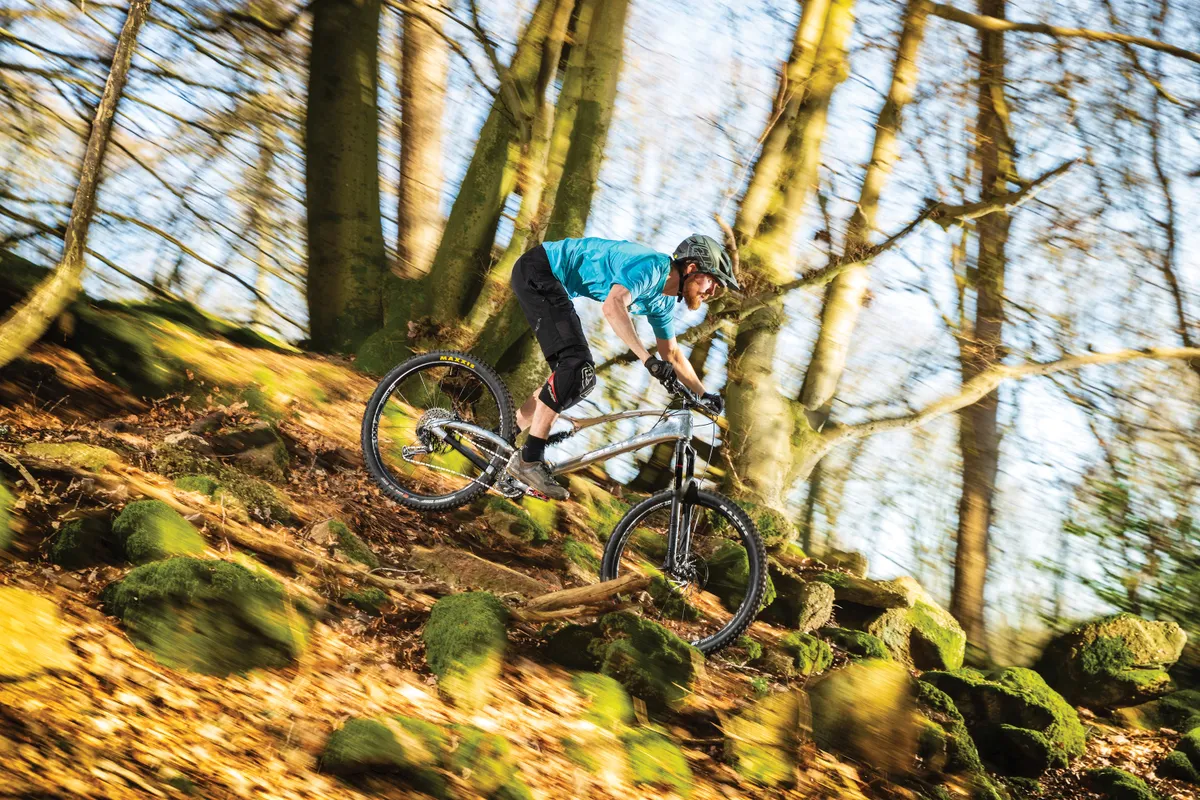The Pole Machine is perhaps the most unusual enduro bike on sale right now, not only in how it’s made or how it looks, but also how it rides.
Where to start? The frame is CNC-machined from pressed billets of 7075-T6 aluminium, which has a high strength-to-weight ratio. This material can’t easily be welded, so the seven machined sections are bolted and glued together.
That may sound worryingly like an Airfix model, but it’s a known technique and I’ve hammered this bike over the past five months with no signs of damage save for some superficial tarnishing.
Two co-rotating links drive the shock to deliver 158mm of travel. The long down tube has room for two full-size water bottles above it plus one more underneath.
The components are decidedly unflashy for such a pricey alloy bike, but they all function solidly. It’s refreshing to see a bashguard fitted as standard too.
The coil shock adds nearly 500g over its air equivalent (which I think works better, if anything) and the RockShox Lyrik RC fork lacks the smoother DebonAir spring, but you can fit this aftermarket and it costs as little as £30.
With these burly components (and not the lightest frame), the complete bike weighs a hefty 16kg.
Pole Machine TR ride impressions

Plumping for the large size (rather than XL), the Pole is still a long bike, with a whopping 520mm reach and 1,335mm wheelbase. This has some downsides, though.
Because the front-centre is so long, you have to ride it in a more forward position to get the front wheel to bite when cornering on flat ground. But because the rear-centre is also lengthy (455mm) and the rear suspension doesn’t squat in corners, it’s possible to get a good weight balance for all types of turn – with practice.
Ride it timidly and you may feel like a passenger on a runaway train, but grab the bull by the horns and you can get it to turn on a dime with practice
Pulling a convincing manual or bunnyhop is difficult and requires a forceful, exaggerated technique. Raising the bar height and softening the shock helps, and I swapped the 40mm stem for a 35mm to make it easier to lift the bike up and over obstacles.
Go too far down this road and you’ll struggle to weight the front wheel, but I found a sweet spot where I could manual and hop just as high as on other bikes without compromising cornering.
You might imagine that a longer bike is harder to get around tight turns, but because it’s so stable that’s not so. The slack head angle and short stem create a feeling of steering from behind the front axle in steep corners, which allows you to chuck the bike into catch berms boisterously with no fear of the front wheel tucking under or spitting you over the bars.
Ride it timidly and you may feel like a passenger on a runaway train, but grab the bull by the horns and you can get it to turn on a dime with practice.

Not surprisingly, the Pole is immensely stable in fast, rocky sections. The rear suspension is well-tuned too. It maintains speed well through the rough and there’s plenty of support to ensure a stable feel when pumping and pedalling with 30 percent sag.
The beginning stroke is super-supple too, so the back-end remains settled and grips well when braking hard on steep and loose surfaces.
The RockShox Lyrik RC fork lacks the small-bump sensitivity of the pricier RC2 version, which compromises front-end traction when it’s lightly loaded and means it transmits more feedback to your hands. When clattering into larger obstacles, though, it’s very competent, with 180mm of travel.
Despite the Machine’s weight, it climbs well too. The 79-degree effective seat angle puts your hips forwards over the bottom bracket, making it easy to prevent front-wheel lift while spinning in a comfortable, efficient position. It pedals efficiently and demolishes steep, technical climbs with dignified ease.

Pole Machine TR geometry (L)
- Seat angle: 79 degrees
- Head angle: 63.9 degrees
- Chainstay: 17.91in / 45.5cm
- Seat tube: 19.29in / 49cm
- Top tube: 25.08in / 63.7cm
- Head tube: 4.92in / 12.5cm
- Bottom bracket height: 13.78in / 35cm
- Wheelbase: 52.56in / 1,335mm
- Stack: 26.98 / 66cm
- Reach: 20.47in / 52cm
Product
| Brand | Pole |
| Price | €5918.00, £5100.00 |
| Weight | 16.00kg |
Features
| Fork | RockShox Lyrik RC, 180mm travel, 51mm offset |
| Stem | Race Face Chester, 40mm |
| Chain | SRAM GX Eagle |
| Frame | CNC-machined 7075 T6 aluminium alloy, 158mm travel (measured) |
| Tyres | Maxxis Minion DHF EXO TR 29x2.5in |
| Brakes | SRAM Code R, 200/200mm rotors |
| Cranks | SRAM GX Eagle, 34t |
| Saddle | Ergon SME3 |
| Wheels | DT Swiss E 1900 Spline rims on DT Swiss 370 hubs |
| Headset | Cane Creek 40-Series |
| Shifter | SRAM GX Eagle |
| Cassette | SRAM GX EAGLE, 10-50t |
| Seatpost | BikeYoke Revive, 160mm |
| Grips/tape | Race Face Lovehandle lock-on |
| Handlebar | Race Face Chester, 780mm |
| Rear shock | RockShox Super Deluxe Coil R |
| Bottom bracket | SRAM DUB |
| Available sizes | S, M, L, XL |
| Rear derailleur | SRAM GX Eagle (1x12) |
